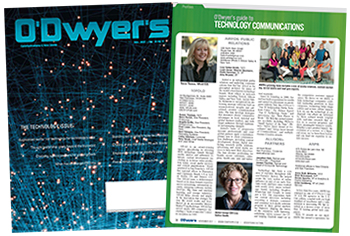|
|
Myths and stereotypes continue to persist in high-tech PR. Most prevalent is the one where you’ve got to be buddies with a business editor or reporter, take him/her to lunch as a way of currying favor and scoring good press. Or at least get a mention in an upcoming article.
That antiquated PR practice is usually at the prodding of company execs. They’re more interested in pumping up stock price at the moment than conveying useful information to their customer base. So, they’re hoping a mention in the Wall Street Journal or New York Times will kick up their stock.
|
|
Accomplished PR pros have outgrown this Madison Avenue schtick of yesteryear. But the mentality still lingers. So, you may wonder — in today’s highly competitive and volatile landscape — what do leading high-tech companies expect out of veteran PR pros? Press mentions? Really?
You can think of mentions as PR with blinders. The reason is the intensity and mental energy of just trying to get a mention not only makes you myopic, but also blocks your views from looking at the broader strategic opportunities high-tech PR offers. To put it another way: the focus and intensity of getting a mention stagnates your thinking and blinds you from a broader view at the strategic opportunities high-tech PR offers.
In most cases, your company or product mention is usually in a series of competitor mentions the reporter uses to highlight the subject he/she is writing about. Or it could be a standalone mention citing your company or product as an example.
What does a mention really get you from a business point of view? Certainly, from the editorial standpoint, that mention or an exec’s quote expands a story, adds more credibility to it.
However, from a business’s point of view, what’s the value? Quite honestly, a mention is rather lightweight and doesn’t convey keywords that search engines pick up and give a company’s marketing message new life as it travels along its viral journey.
On the other hand, to be fair, a mention in top national business publications like the New York Times and Wall Street Journal is nothing to sniff at or lightly brush off. But still, those mentions are often few and far between, non-strategic, and actually, forgotten in no time.
And who knows what slant that particular article takes when your product or service is mentioned. You’ll never know until the article is published, and then you’re either a hero or a persona non grata. In effect, you’re rolling the dice. You’re lucky if you get a positive mention.
The faulty assumption on the part of the PR pro is that he/she will get a favorable mention. Unfortunately, for that naïve PR pro, the objective of a straight reporting business publication article is usually to cover a particular issue and not to hype or glorify a particular business or technology subject.
Editor lunches so yesterday
Savvy high-tech PR pros know it’s so yesterday to take editors out to lunch to try to wrangle stories. Editors tell you up front that proposed stories stand on their own, so no need to try to curry favor with them. Instead, most PR pros work toward understanding editorial needs and polishing their stories to meet those requirements. No need to check out favorite restaurants for editors as part of the PR pro’s job description.
What you have to keep in mind is the high-tech landscape is extremely competitive. It doesn’t matter whether you’re a chipmaker, a computer vendor or software company, there are always highly aggressive competitors nipping at your heels, and most often they aren’t so gentle about it. They are more than willing to run you out of business.
A lot of high tech companies haven’t yet learned that PR is a top-notch tool to help maintain a competitive edge. But you’ve got to nurture it and use it in the right way. The wrong way is to use yesterday’s thinking and practices, in general, being random and reactive, and solely going after press mentions or cranking out press releases.
You have to be strategic, or put another way, you’ve got to use a well-organized and sustained methodology coupled with content marketing to effectively get your messages across to the right audiences.
Better ways
There are better ways of gaining coverage in the trade and business press than trying solely for mentions. A good route to take is to collaborate with marketing and sales to lay out a strategy, a plan, if you will, that clearly defines the what, when and how to launch and sustain a content marketing/PR campaign.
Once you get rolling on that plan, it’s always on because you are constantly generating new content from your subject matter experts or SMEs to keep the content engine well fueled and in tip-top condition.
Have you thought about scheduling your CEO or CTO to speak at top industry conferences, ghostwriting speeches and abundantly sprinkling them with industry issues? That approach will draw editors like a magnet because that’s where they live. They want to get perspective on top issues.
There are also great opportunities with a sustained program of technology-contributed articles. As mentioned earlier, Silicon Valley marketing execs have this notion that a PR maven must be buddy-buddy with business editors to get that much sought after mention. But think about it, business editors are hard to convince, plus they get a gazillion PR story queries a week.
Your story has a better chance of getting business editorial attention via contributed articles in the trade press. How is that possible? As far back as the invention of the silicon transistor, business editors have relied on trade press articles to keep them abreast of the latest technology developments.
Today, you can add blogs as another strategy for getting the word to business editors. For instance, techtarget.com has increasingly become popular with its multiple technology editorial sites for news and blogs. One particular site, IoT Agenda, offers the opportunity to post blogs on an arranged monthly schedule — just as long as the blogs are useful to readers and not laden with product hyperbole.
It’s not only business editors, but market and financial analysts also rely on technology trade press articles and blogs to keep them up to date. That’s where your story and your messages really shine and get considerable attention by those key influencers. So, rather than constantly deploying the frontal approach for your business story, try the flanking movement like that taught in ROTC 101. Strategically finesse your technology content via a well-organized contributed article program, instead of trying to force it down editors’ throats. You’d be surprised at the results. Pretty soon editors start coming to you, instead of you dogging them for a mention.
There’s another important point about contributed articles and blogs. Most often, the right keywords go viral, thanks to search engines. Business editors often conduct their research these days by entering keywords on Google, and voila, are presented with a motherlode of up-to-date tech content, and lots of times, those are either published contributed articles, blogs or technical papers.
Once they come across your exec’s contributed article or blog, you’ve captured the business editor’s attention. As he/she sees more of your technology pieces on search engines, the more influence you’re building. Chances are, when your technology topic comes up for business reporting, those editors will be calling you.
Wouldn’t it be much more effective, less hassle, and with fewer rejections to allow technology and contributed articles/blogs to open editorial doors for you, instead of working so hard for a press mention?
***
Dan Garza is a marketing PR professional and veteran observer of Silicon Valley PR. He’s collaborated with top technology companies and was instrumental in creating and implementing successful PR strategies at these firms.

 Dan Garza
Dan Garza

 Laura Anderson, who rose to VP/GM of global communications and events in a nearly 20 year stint at Intel, will take on the Americas technology chair at Burson following the completion of the BCW and H+K merger on July 1.
Laura Anderson, who rose to VP/GM of global communications and events in a nearly 20 year stint at Intel, will take on the Americas technology chair at Burson following the completion of the BCW and H+K merger on July 1. WE Communications has partnered with ROKK Solutions to form the WE ROKK AI service.
WE Communications has partnered with ROKK Solutions to form the WE ROKK AI service. In the dynamic world of modern business, effective communication is a pivotal tool for success across various industries. At Communications Strategy Group (CSG®), our expertise in embracing innovation in communication extends beyond traditional marketing strategies, paving the way for transformative industry-specific solutions.
In the dynamic world of modern business, effective communication is a pivotal tool for success across various industries. At Communications Strategy Group (CSG®), our expertise in embracing innovation in communication extends beyond traditional marketing strategies, paving the way for transformative industry-specific solutions. There are two types of tech PR professionals. Which one are you? And are C-suite executives making that decision for you?
There are two types of tech PR professionals. Which one are you? And are C-suite executives making that decision for you? While there’s an impulse to grab reporters’ attention with the newest industry-transforming tech product or service, a back-to-basics approach focused on telling the right stories to the right people is a far more successful way to ensure your technology campaign breaks through the clutter of today’s crowded tech landscape.
While there’s an impulse to grab reporters’ attention with the newest industry-transforming tech product or service, a back-to-basics approach focused on telling the right stories to the right people is a far more successful way to ensure your technology campaign breaks through the clutter of today’s crowded tech landscape.


 Have a comment? Send it to
Have a comment? Send it to 
No comments have been submitted for this story yet.